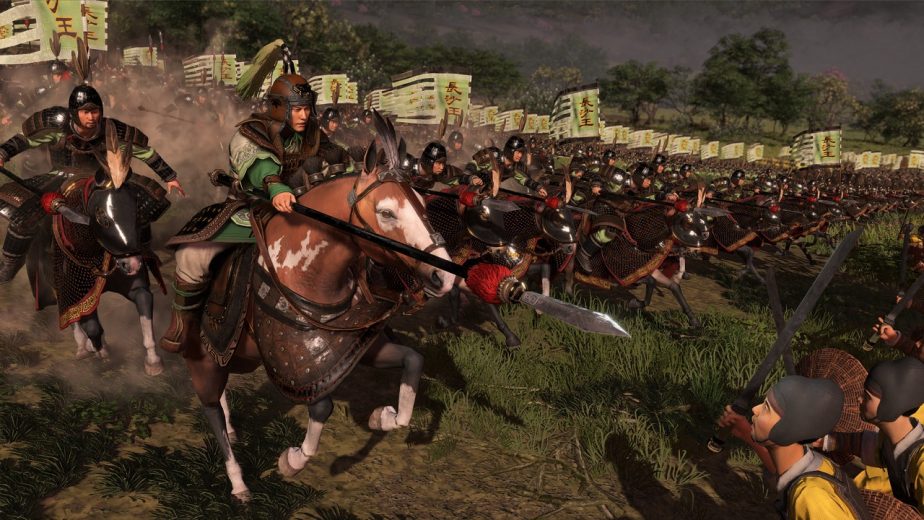The Total War: Three Kingdoms Eight Princes DLC is due to release on the 8th of August, in less than two weeks’ time. The first major post-launch DLC for Creative Assembly’s highly successful strategy game, Eight Princes features a whole new campaign set 100 years after the main game. It also features the eight princes themselves as eight new playable faction leaders. Alongside characters like Sima Wei and Sima Lun, Sima Ai has a distinct playstyle which is quite different from any in the main game.
Sima Ai in the Total War: Three Kingdoms Eight Princes DLC
Among the eight princes, Sima Ai is one of two who have the Champion class, alongside Sima Liang. However, he has a very different playstyle to the Rightful Regent. Known as “The Principled Administrator,” Sima Ai’s playstyle focuses on the development of his commandery capitals. He makes use of a unique resource called Reformation, which he can generate by developing his settlements. His Reformed Infrastructure trait causes buildings in his commander capitals to either increase or decrease Reformation. The more Reformation he acquires, the better his trade influence and faction research speed becomes. In fact, Reformation even lowers corruption.

Sima Ai has access to two unique commandery assignments which relate to Reformation. The first is Restructure Administration. This boosts the amount of Reformation gained from buildings in the local commander. His other assignment is Regulate Markets. This decreases his Reformation but in exchange, boosts his income from commerce, silk, and spices. Sima Ai has access to two unique units; the Infantry of Jing and the Archers of Jing. The former are well-armoured polearmy infantry, best used against enemy cavalry. The latter are exceptional archers with both high ammunition and very high damage. His archers are even better thanks to one of his character traits, which gives all ranged units in his faction +25% ammunition. His second trait gives all units +10 morale when defending.
Sima Ai’s start position lies slightly south of Sun Jian’s start position in the main game, and like Sun Jian, he is in a good position for southward expansion. He benefits from control of a Master Armourer resource at the start; a very valuable asset so early in the game. His sole noteworthy character is Huangfu Shang.
Sima Ai in the War of the Eight Princes
“Sima Wei’s brother of the same mother (concubine Consort Shen), Sima Ai was praised by many for his filial piety,” explains Creative Assembly; “He supported Sima Wei in his coup against regent Sima Liang, and when Empress Jia had Sima Wei executed, Sima Ai was demoted as the supporter of a criminal. In subsequent years, he became known as a reformist, and as a diligent administrator with humility and great talent. Of all the princes, he was possibly the most dutiful to the true Emperor Hui, despite his disabilities, and always paid him respect.”

Indeed, Sima Ai’s role in the War of the Eight Princes began when he aided Sima Wei in his coup against Sima Liang and Wei Guan. However, after Empress Jia betrayed Sima Wei just days later, Sima Ai was demoted to Prince of Changsha. In the year 301, Sima Lun overthrew Emperor Hui and named himself emperor, prompting several other princes to stage a rebellion. Sima Ai led an army in this rebellion and fought alongside Sima Ying and Sima Jiong. However, after they successfully overthew Sima Lun and restored Emperor Hui, Sima Ai was not rewarded for his aid.
Sima Yong’s Conspiracy and the Cruel Fate of Sima Ai
In place of Sima Lun, Sima Jiong became regent. However, he also became increasingly arrogant and paranoid, particularly towards Sima Yong. In response, Sima Yong conspired with Sima Ai to overthrow him. However, Sima Yong was actually manipulating Sima Ai, believing that his rebellion would fail but weaken Sima Jiong enough that Sima Yong and Sima Ying could overthrow him themselves. (Whereupon they planned to dethrone Emperor Hui and make Sima Ying emperor.) In the year 302, the rebellion began. Sima Jiong’s first act was to launch a preemptive strike against Sima Ai, but the prince was able to defeat him, seize control of the emperor and execute Sima Jiong.

Sima Ai subsequently took up the position of regent and set about an effort to reform the Jin government. During this time, he attempted to share power with Sima Ying. However, the next year, Sima Yong persuaded Sima Ying to overthrow Sima Ai; after all, the prince’s unexpected victory over Sima Jiong had upset their plan to make Sima Ying emperor. Although Sima Ai tried to make peace, his adversaries refused. However, despite facing greater numbers, Sima Ai’s forces nonetheless managed to hold out against the combined attack.
The war came to an end in 304 when Sima Yue, the Prince of Donghai, betrayed Sima Ai. Believing that his defeat was inevitable, the prince arrested him and surrendered the capital of Luoyang. Sima Ai was delivered to Sima Yong, who executed him by burning him alive. As Creative Assembly notes; “The most poignant moment of Sima Ai’s life came at the end: before being burned to death as a traitor by the rebels Sima Ying and Sima Yong, he wrote a touching farewell letter to Emperor Hui.”




